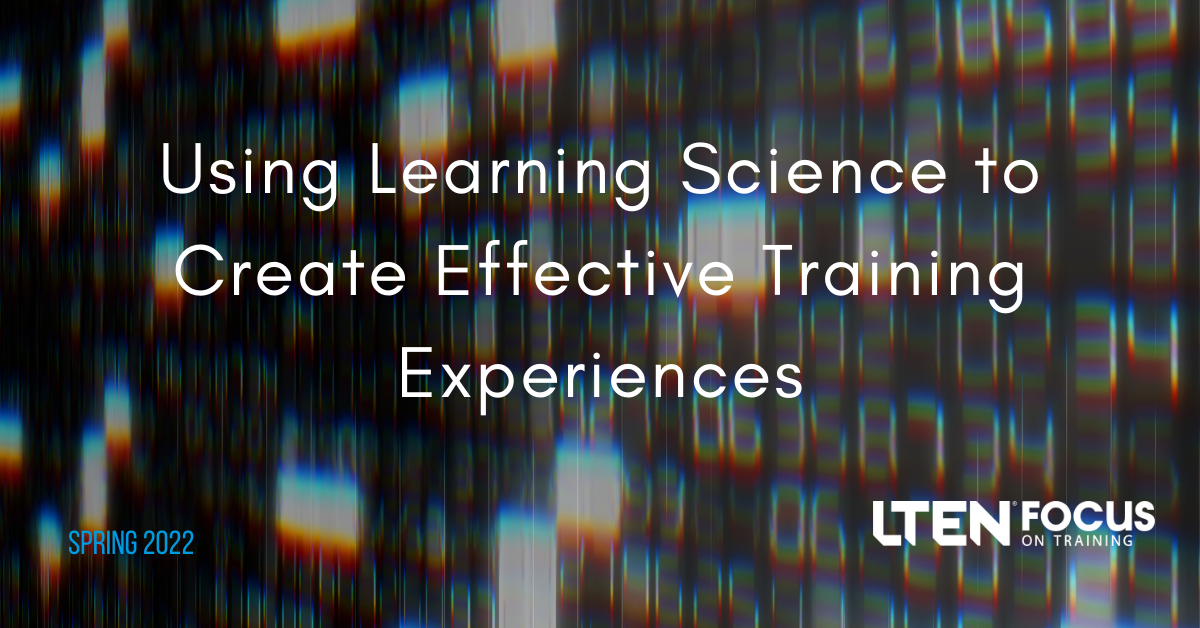
Using Learning Science to Create Effective Training Experiences
Feature Story – By Steven Just, Ed.D.
Over the past 20 years, we have learned a lot about how people learn and retain what they have learned.
Since learning is a science, our day-to-day practice should reflect that fact. Just as the day-to-day practice of chemists (for example) is grounded in the body of knowledge that defines chemistry, our instructional strategies and learning technologies should be consistent with what we know about the learning process.
Unfortunately, too often we chase the latest training fad or the hottest, newest technology without asking a fundamental question: Does our understanding of learning science justify this training strategy?
In this article, we will look at six important learning principles and see how we can and should apply them to our daily practice.
What Is Learning?
Let’s begin by defining learning. Although you will encounter many definitions, we prefer the following set of core principles. Learning is a change in knowledge or behavior that is:
- Durable/persistent over time. If we learn something (maybe even pass a test on it) but then quickly forget it, we really haven’t learned it.
- Generalizable/flexible. This is particularly applicable to skills. When we are trained in new skills, we are often presented with “model” situations. Real life rarely conforms to models; we usually encounter variations on these models. How good are we at adapting and flexibly applying what we have learned?
- Available on demand. Not all learning has to be available on demand, but many jobs (e.g., sales) require the practitioner to have certain key concepts and information rapidly available. In learning science this is called automaticity.
- Connected to prior knowledge. The key to meaningful learning is to build schema or interconnected webs of knowledge. This allows us to generalize and make connections, and reason by analogy, so we can solve new, unfamiliar problems. Anything learned in isolation from what we already know is useless and usually quickly forgotten.
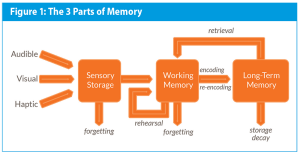 How Do We Learn?
How Do We Learn?
To understand how we learn, we need to take a quick look at how memory is organized. Figure 1 shows three parts to memory:
- Sensory memory is everything our senses encounter: sounds, images, smells, etc. Most of this is quickly forgotten.
- Working memory is where we process what we want to remember. Unfortunately, working memory is very limited, in both capacity and longevity, so anything we do want to remember for more than just a few minutes must be stored in long-term memory.
- Long-term memory is where we store all the knowledge and skills we want to use or recall at a later time. Unfortunately, long-term memory is not like a computer disk. It is not permanent. We forget – even things we want to remember. This is called storage decay.
To make things stick in long-term memory we need to recall from long-term memory back into working memory, reprocess it and re-store it back into long-term memory. This is called the encoding/re-encoding process.
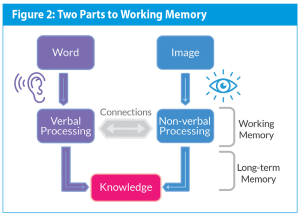 Working Memory
Working Memory
Working memory is key to learning and reasoning. Think of it as your brain’s central processing unit. Since working memory is so limited, we must be careful about not overloading it (this is called Cognitive Load Theory).
Critically, there are two parts to working memory (see Figure 2): One processes images, the other verbal information.
Putting Learning Science Into Practice
To be effective, learning practice must be consistent with what we know about the learning process. Let’s now look at six learning principles and see what learning practices they lead to.
 Encoding/Re-Encoding
Encoding/Re-Encoding
Providing opportunities for retrieval practice exercises the encoding/reencoding process, strengthening neural connections, making it more likely that new information will not be forgotten and can be retrieved on demand. This is also sometimes called the testing effect. (See Figure 3.)
Evidence-based Practices: Assessments for learning (i.e., frequent low-stakes quizzes). Adaptive questioning exercises. Gamification that uses questioning. Cumulative exams.
Reducing Cognitive Load
Since our working memories can only process relatively few independent pieces of information at any time, we should create training that does not overwhelm working memory.
Evidence-based Practices: Microlearning. Spacing learning over time, rather than in “massed” learning events.
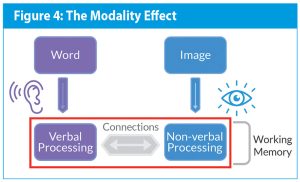 Dual Encoding
Dual Encoding
When we use both channels of working memory (visual and auditory) we improve learning. This is also sometimes called the multimedia effect. The modality effect states that the combination of animation and narration is superior to animation plus on-screen text. (See Figure 4.)
Evidence-based Practices: Combine graphics/animation with narration. Caution: Do not combine graphics/animation and narration with on-screen text of the narration. This overloads the image channel.
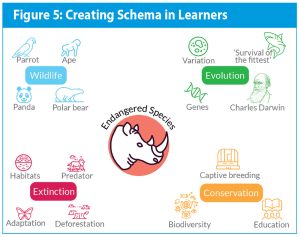 Creating Schema
Creating Schema
We need to facilitate the creation of schema in our learners. We do this by providing information in a way that permits the learners to build mental models. (See Figure 5.)
Evidence-based Practices: Use “advanced organizers.” Provide opportunities for pre-learning before a learning event. This pre-learning can take the form of microlearning nuggets and even “priming” quizzes. Ensure that main ideas are clear and the interconnections among main ideas are obvious to the learner.
Cognitive Effort
Learners create stronger connections among neurons by exerting cognitive effort.
Learning that is too easy is probably not teaching anything meaningful and learning that is too difficult is often an inefficient use of time. We need to find the sweet spot. That sweet spot is called desirable difficulties.
Evidence-based Practices: Start simple and then build complexity. Increase task difficulty adaptively. Use low-stakes testing rather than encouraging restudying. Provide skills practice that requires learners to adapt previously learned skills to new, unfamiliar situations.
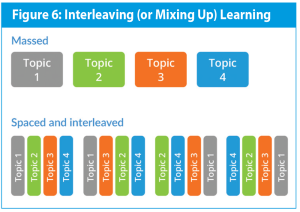 Interleaving
Interleaving
Most learning material is presented and practiced sequentially (e.g., first we teach addition, then subtraction, then multiplication, then division). While presenting material sequentially may be necessary because one skill builds on the previous skill, practice does not need to be grouped by topic. There is a lot of research evidence to show that mixing up practice (i.e., interleaving) leads to improved learning outcomes. (See Figure 6.)
Evidence-based Practices: Do not group practice by subject. For example, on a formative exam (i.e., a non-high-stakes exam) intermix questions from different modules. On module-level exams incorporate questions from previous modules (cumulative exams). For skills training, intermix different types of situations for practice.
Conclusion
If we believe that learning is a science, then it follows that training is most effective when we base our instructional practices on what we know about the learning process.
Steven Just, Ed.D., is CEO and principal consultant at Princeton Metrics, specializing in life science assessment development, validation, and delivery, microlearning and learning technology. He can be reached at sjust@princetonmetrics.com.








